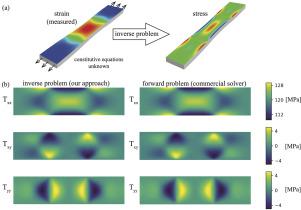Journal of the Mechanics and Physics of Solids ( IF 5.3 ) Pub Date : 2020-11-06 , DOI: 10.1016/j.jmps.2020.104186 Benjamin C. Cameron , C.Cem. Tasan

|
Recent developments in imaging techniques and correlation algorithms enable measurement of strain fields on a deforming material at high spatial and temporal resolution. In such cases, the computation of the stress field from the known deformation field becomes an interesting possibility. This is known as an inverse problem. Current approaches to this problem, such as the finite element update method, are generally over-determined and must rely on statistical approaches to minimize error. This provides approximate solutions in some cases, however, implementation difficulties, computational requirements, and accuracy are still significant challenges. Here, we show how the inverse problem can be formulated deterministically and solved exactly in two or three dimensions for large classes of materials including isotropic elastic solids, Newtonian fluids, non-Newtonian fluids, granular materials, plastic solids subject to co-directionality, and some other plastic solids subject to associative or non-associative flow rules. This solution is based on a single assumption of the alignment of the principal directions of stress and strain or strain rate. No further assumptions regarding incompressibility, pressure independence, yield surface shape or the hardening law are necessary. This assumption leads to a closed, first order, linear system of hyperbolic partial differential equations with variable coefficients. The solution of this class of problems is well established and hence the equations can be solved to give the solution for any geometry and loading condition, enabling broad applicability to a variety of problems. We provide a numerical proof-of-principle study of the plastic deformation of a two-dimensional bar with spatially varying yield stress and strain hardening coefficient. The results are validated against the solution of the corresponding forward problem - solved with a commercial finite element solver - indicating the solution is exact up to numerical error (the normalized root mean square error of the stress is ). No model calibration or material parameters are required. The sensitivity of the solution to error in the input data is also analyzed. Interestingly, this solution procedure lends itself to a simple physical interpretation of stress propagation through the material. Finally, we provide some examples showing how this approach may be analytically applied to both solid and fluid mechanics problems.
中文翻译:

从测得的形变场进行全场应力计算:双曲公式
成像技术和相关算法的最新发展使得能够以高空间和时间分辨率测量变形材料上的应变场。在这种情况下,从已知形变场计算应力场成为一种有趣的可能性。这被称为反问题。当前解决该问题的方法,例如有限元更新方法,通常是过高确定的,必须依靠统计方法来最大程度地减少误差。在某些情况下,这提供了近似的解决方案,但是,实现难度,计算要求和准确性仍然是严峻的挑战。在这里,我们展示了如何确定性地解决反问题,并针对二维材料(包括各向同性弹性固体)在二维或三维中精确地求解,牛顿流体,非牛顿流体,颗粒材料,受同向性影响的塑料固体,以及受其他或不相关流动规则影响的其他一些塑料固体。该解决方案基于应力和应变或应变率的主要方向对齐的单一假设。不需要关于不可压缩性,压力无关性,屈服面形状或硬化规律的进一步假设。该假设导致具有可变系数的双曲型偏微分方程的封闭的一阶线性系统。这类问题的解决方案已得到很好的建立,因此可以对方程进行求解,以提供针对任何几何形状和载荷条件的解决方案,从而广泛适用于各种问题。我们提供具有空间变化屈服应力和应变硬化系数的二维钢筋塑性变形的数值原理研究。针对相应的正向问题的解决方案对结果进行了验证(使用商用有限元求解器进行了解决),表明该解决方案在达到数值误差之前都是精确的(应力的归一化均方根误差为)。无需模型校准或材料参数。还分析了解决方案对输入数据错误的敏感性。有趣的是,这种解决方法适用于应力在材料中传播的简单物理解释。最后,我们提供一些示例,说明如何将该方法解析地应用于固体和流体力学问题。


























 京公网安备 11010802027423号
京公网安备 11010802027423号